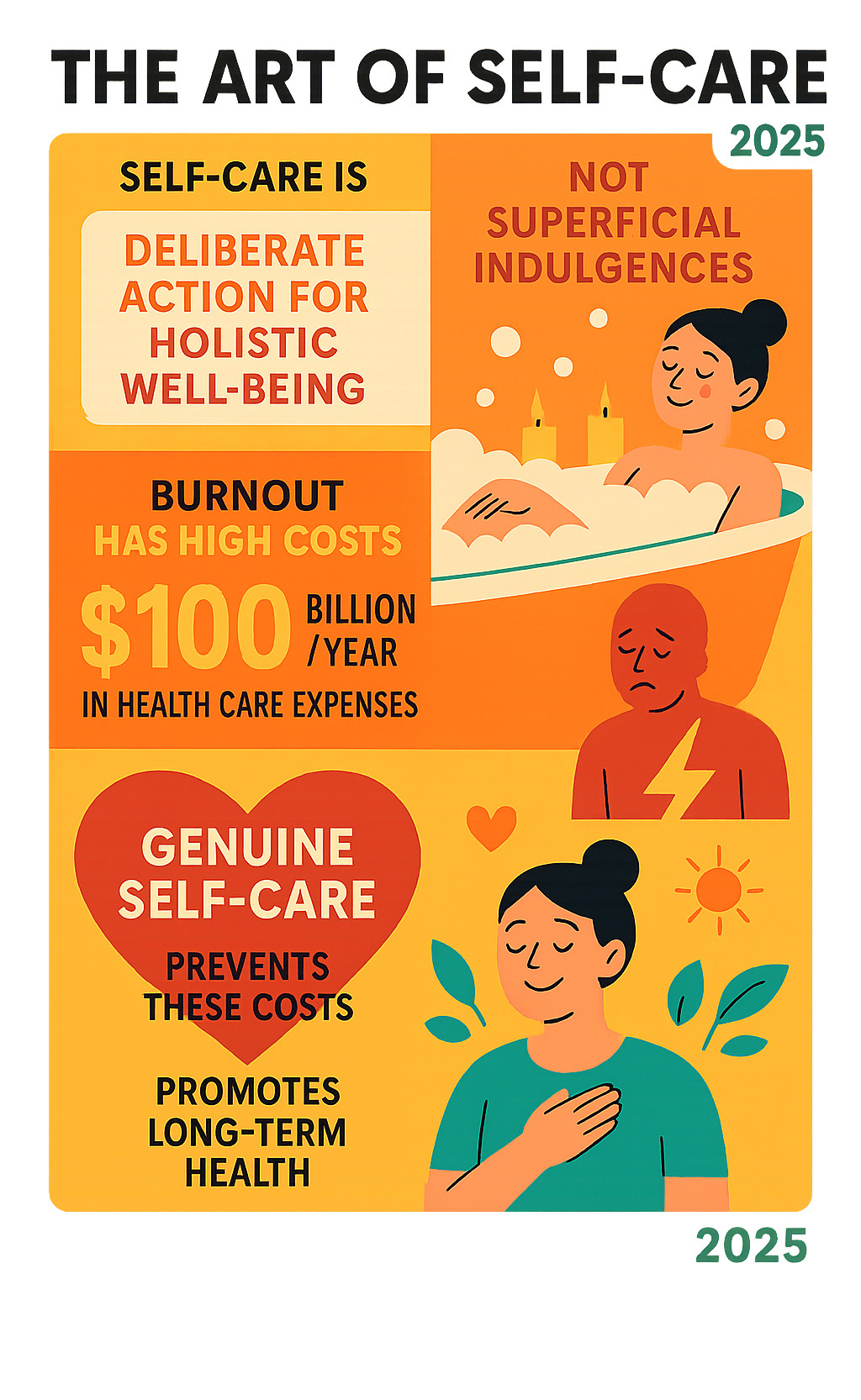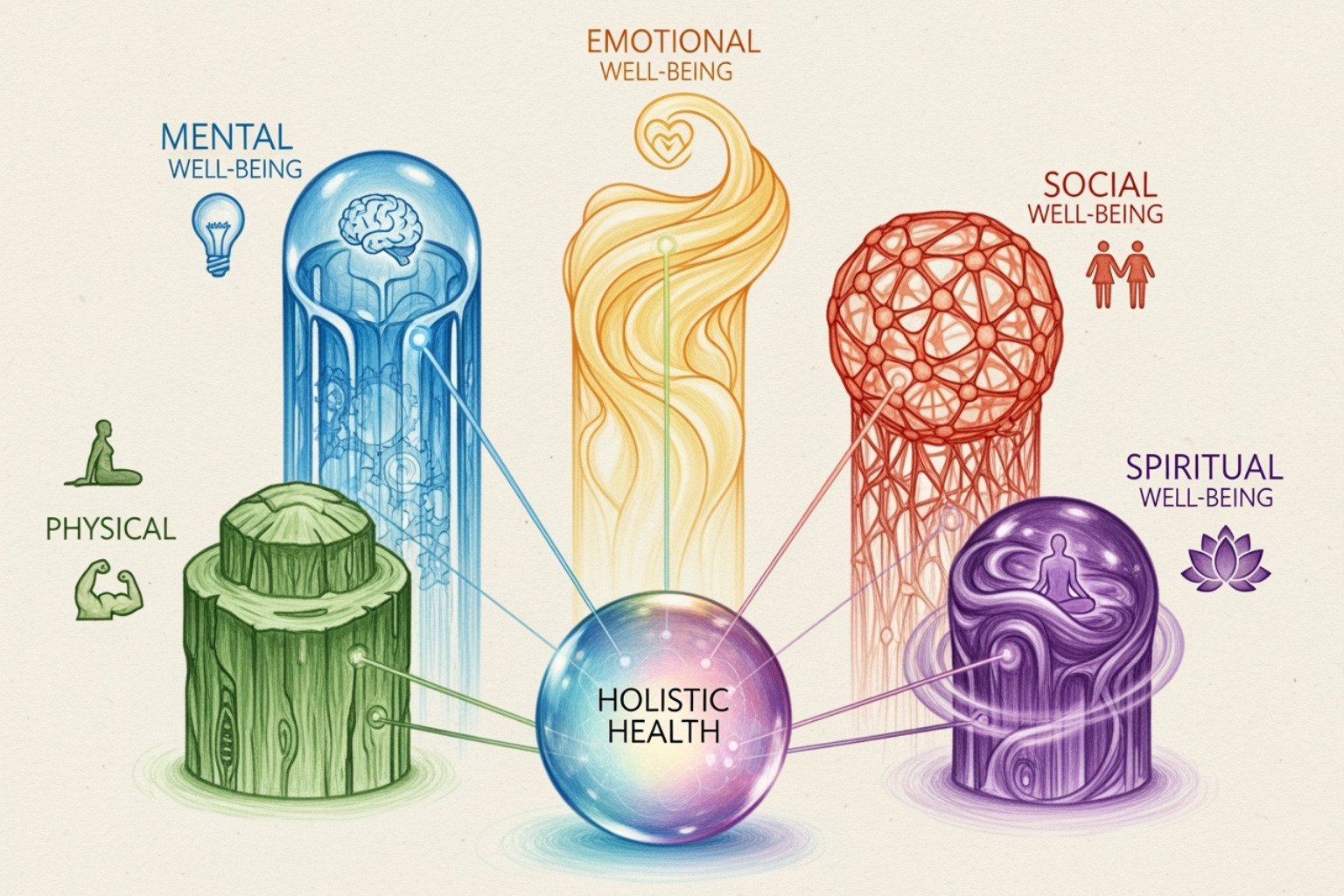Understanding the Art of Self-Care
The art of self care is far more than just a fleeting trend or a superficial indulgence. It’s a deliberate, ongoing practice of listening to your deepest needs and taking action to support your holistic well-being. Often confused with pampering or marketed as luxury products, genuine self-care is a foundational pillar for a healthier, more balanced life.
To truly practice the art of self care:
- Listen to your needs: Pay close attention to what your physical, mental, emotional, social, and professional self truly requires. This goes beyond what others expect or what marketing tells you.
- Act deliberately: Self-care involves conscious choices and actions, not just passive activities or quick fixes.
- Prioritize well-being: Understand that tending to yourself is not selfish, but essential for sustained energy, resilience, and the capacity to show up fully for yourself and others.
- Accept it as a journey: Self-care isn’t a one-time event; it’s a dynamic, personalized process that evolves with you.
In today’s world, many people, like Eco-conscious Emma, find themselves overwhelmed, struggling with burnout, and losing touch with what truly nourishes them. The statistics are stark: employee burnout is costing over $100 billion per year in health-related expenses, leading to serious health issues. This highlights a critical need to redefine and reclaim self-care from its commercialized interpretations.
This guide will help you steer past the common misconceptions to uncover the genuine essence of self-care. You’ll learn how to identify your unique needs and integrate powerful, personalized practices into your daily life, changing self-care into a sustainable and truly transformative art form.

The art of self care vocabulary:
Redefining Self-Care: Beyond the Commercial Hype
Picture this: you’re scrolling through social media and see yet another post about “self-care Sunday” featuring expensive candles, luxury face masks, and champagne in a bubble bath. While these moments can be lovely, they’ve created a narrow view of what self-care actually means.
The art of self care has been hijacked by marketing teams who want to sell us products. But here’s the truth: genuine self-care is simply any activity we do deliberately to take care of our mental, emotional, physical, social, and professional health. It’s not about what you buy – it’s about the conscious choices you make to support your overall well-being.
The difference between genuine and fake self-care is like the difference between eating a nourishing meal when you’re hungry versus stress-eating a bag of chips. One addresses your actual needs, while the other might feel good in the moment but leaves you feeling worse later.
Real self-care is proactive. It’s listening to your body’s signals and addressing your core needs before you hit a wall. Think about Japan’s work culture – the problem of excessive work became so severe that the government had to pass laws limiting work hours and requiring vacation days. That’s what happens when we ignore genuine self-care.
The stakes are higher than we might think. Employee burnout costs over $100 billion per year in health-related expenses. Job burnout alone accounts for $125 billion to $190 billion in healthcare spending annually and has been linked to serious conditions like type 2 diabetes, coronary heart disease, and even premature death. This is exactly Why Self-Care is So Important – it’s not a luxury, it’s preventative medicine.
| Genuine Self-Care (Long-term Well-being) | Self-Indulgence (Short-term Pleasure) |
|---|---|
| Deliberate action for holistic health | Often impulsive, seeking immediate gratification |
| Addresses root causes of stress/fatigue | May distract from underlying issues |
| Builds resilience and capacity | Can lead to guilt, regret, or further depletion |
| Nourishes mind, body, and spirit | Often involves numbing behaviors or excessive consumption |
| May not always feel “fun” in the moment | Primarily driven by comfort or instant gratification |
The Difference Between Self-Care and Self-Indulgence
Here’s where things get interesting: self-care doesn’t always feel good in the moment. Sometimes it means saying no to plans when you’re exhausted, even though you’ll disappoint friends. Sometimes it’s choosing to go to bed early instead of binge-watching another episode.
Intentionality is everything. When you choose activities that genuinely serve your long-term well-being, you’re practicing true self-care. You’re addressing your core needs rather than just seeking comfort or avoiding discomfort.
Self-indulgence, on the other hand, is often about numbing or escaping. It might involve impulse buying, excessive drinking, or constantly saying “yes” to everything because of FOMO. These behaviors might feel like self-care, but they’re more like putting a band-aid on a broken bone.
As Deborah Serani Psy.D. beautifully puts it, Self-care is care provided for you, by you. It’s about making conscious choices that truly contribute to your well-being, not just seeking quick fixes or fleeting highs.
The beauty of Good Self Care is that it builds your emotional and physical stamina over time. It creates resilience rather than depleting it.
The Connection to Self-Love and Self-Compassion
At its heart, the art of self care is really about treating yourself with the same kindness you’d show a good friend. It’s about recognizing your self-worth and acting accordingly.
When you practice genuine self-care, you’re sending yourself a powerful message: “I am worthy of care and attention.” This isn’t narcissistic – it’s foundational. You can’t pour from an empty cup, as they say.
Self-compassion means moving beyond harsh self-criticism. Instead of “shoulding” yourself into unhealthy habits (“I should work later,” “I should skip lunch”), you start treating yourself with understanding and patience. You begin to respect yourself enough to set boundaries and prioritize your needs.
This shift is transformative. As explored in Self-Care IS Self-Love, this practice often becomes the starting point for deeper healing. When you prioritize self-love through intentional self-care, you create conditions for real, lasting change.
The beautiful thing is that this inner nourishment often shows up on the outside too. There’s a real connection between how we care for ourselves internally and how we look and feel, which impacts our Beauty and Mental Health. When you’re truly taking care of yourself, it radiates outward.
The Pillars of Well-being: A Holistic Self-Care Framework

Think of the art of self care like tending a garden. Just as a thriving garden needs water, sunlight, good soil, and protection from harsh weather, our well-being flourishes when we nurture all aspects of ourselves. This holistic approach to wellness creates a strong foundation that naturally prevents burnout and supports us through life’s ups and downs.
When we only focus on one area – say, just our physical health – we’re like a three-legged stool missing a leg. We might function for a while, but eventually, we’ll wobble and fall. True wellness happens when we care for our physical, mental, emotional, social, and spiritual selves as interconnected parts of who we are. As we explore in The Ultimate Guide to Wellness and Well-being, this integrated approach creates lasting change.
Physical Self-Care
Your body is your home for life, and physical self-care is about treating it with the love and respect it deserves. This isn’t about perfection or following the latest health trend – it’s about listening to what your body actually needs.
Nourishing food forms the foundation of physical wellness. When we fuel ourselves with fresh, energizing foods, we’re not just feeding our bodies – we’re supporting our mood, energy levels, and even our skin’s natural glow. This connection runs deeper than you might think, as we find in The Connection Between Gut Health and Glowing Skin. Cooking at home when possible and choosing locally sourced produce isn’t just trendy – it’s a genuine act of self-love.
Quality sleep goes beyond just getting eight hours. It’s about creating a sleep sanctuary and honoring your body’s natural rhythms. Maybe that means putting your phone away after 9 PM or creating a calming bedtime ritual that signals to your body it’s time to rest and restore.
Mindful movement transforms exercise from punishment into pleasure. Whether you’re dancing in your living room, taking a gentle walk in nature, or stretching on your bedroom floor, the goal is joyful movement that makes you feel alive. Even a short walk outside can work wonders for reducing stress and helping you feel more present in your body.
Rest encompasses those precious moments of pause throughout your day. It’s listening when your body whispers for a break instead of waiting until it screams. This also includes caring for your skin with gentle, natural approaches, as outlined in our Natural Skincare Tips.
Emotional & Mental Self-Care
Your inner world deserves just as much attention as your physical health. This dimension of self-care helps you process feelings, manage stress, and cultivate a healthier relationship with your thoughts.
Journaling acts like a trusted friend who’s always available to listen. Research shows that just 15-20 minutes of writing can help us cope with traumatic, stressful, or emotional events. Whether you prefer structured prompts or free-flowing thoughts, journaling creates a safe space to untangle your feelings and gain clarity on what’s really going on inside.
Setting boundaries might feel uncomfortable at first, but it’s one of the most loving things you can do for yourself. It’s learning to say “no” to demands that drain your energy and “yes” to what truly matters. Boundaries aren’t walls – they’re gates that let in what nourishes you and keep out what depletes you. This practice is essential for maintaining Emotional Health.
Mindfulness brings you back to the present moment, where life actually happens. This doesn’t require hours of meditation – it can be as simple as taking three deep breaths, savoring your morning coffee, or fully focusing on whatever task is in front of you. The transformative power of conscious breathing is beautifully explored in The Power of Breathwork for Wellness and Inner Glow.
Seeking therapy or support shows incredible strength and self-awareness. Recognizing when you need professional help or simply a trusted friend to talk through challenges is a profound act of self-care. We all need support sometimes, and asking for it is brave, not weak.
Social, Spiritual, and Professional Self-Care
These often-overlooked areas of self-care extend beyond the individual to encompass your connections, purpose, and work life. They’re just as vital for your overall well-being.
Community and meaningful relationships feed your soul in ways nothing else can. Social self-care means understanding your own social needs – whether you’re someone who thrives in large groups or prefers intimate one-on-one connections. It’s about nurturing relationships that lift you up and creating a “community of care” where support flows both ways.
Spiritual self-care doesn’t require any specific religious beliefs. It’s about connecting with something larger than yourself, whether that’s nature, your values, or a sense of purpose that gives your life meaning. This might look like morning gratitude, time in your garden, or quiet moments of reflection that help you remember what truly matters.
Professional self-care has become crucial in our always-connected world. It’s setting healthy boundaries between work and home, taking real breaks during your day, and recognizing that rest isn’t laziness – it’s necessary maintenance. Learning to ask for help and knowing your limits protects you from the burnout that’s become all too common. For inspiration on creating this balance, read From Burnout to Balance: One Woman’s Journey to Holistic Living.
Sometimes, the most caring thing you can do is step away from the digital noise that constantly demands your attention. A Digital Detox: A Wellness Reset for Your Mind and Skin can help you reconnect with yourself and what really matters.
Mastering the Art of Self-Care: Creating Your Personal Plan

Now that we’ve explored the true meaning of self-care, it’s time to put it into practice. Creating a self-care plan isn’t about following rigid rules or someone else’s idea of wellness. Instead, it’s about making your self-care truly yours – personalizing and sustaining practices that genuinely work for you. The art of self care is incredibly individual, constantly adapting to your unique needs and the twists and turns of life. It calls for actionable strategies and a gentle commitment to navigating the common problems that pop up along the way. For a broad overview, our Wellness Lifestyle Tips offer a fantastic place to begin your journey.
How to Identify Your Unique Needs
Before you can build a self-care plan that truly sticks, you need to become an expert in your own needs. This involves a beautiful process of self-assessment and deeply listening to what your body and mind are telling you.
Your body often sends you little whispers (or sometimes loud shouts!) before your mind even catches on. Are you feeling constantly tired, tense, or restless? These are important cues! Learning to listen to your body is a powerful first step. Similarly, regular emotional check-ins are vital. How are you truly feeling today? What thoughts are swirling in your mind? Are you feeling overwhelmed, a bit anxious, or perhaps wonderfully joyful? Journaling can be an incredible tool here, helping you track these feelings and understand their patterns.
To help you pinpoint specific areas that might need a little extra love, tools like this Self-Care checkup to identify areas of focus can be incredibly insightful. And if you love to plan, our Your Monthly Self-Care Planner: Printable Wellness Tracker can guide you through this process step-by-step. Your needs aren’t set in stone; they change as you do. So, this isn’t a one-and-done assessment, but an ongoing conversation with yourself.
Practical Steps for Daily Integration
Once you have a clearer picture of your unique needs, the exciting part begins: weaving self-care seamlessly into your daily life. It doesn’t have to be a huge, time-consuming overhaul.
The best way to start is by starting small. Don’t try to change everything at once! Even just 5 minutes of focused self-care can create a ripple effect. Think about habit stacking – linking a new self-care habit to something you already do. For instance, if you always make coffee in the morning, why not try 3 minutes of deep breathing while the coffee brews? Or if you always brush your teeth before bed, add a minute of gentle stretching right after.
Most importantly, commit to scheduling self-care. Treat these moments as non-negotiable appointments, just like a work meeting or a doctor’s visit. When it’s on your calendar, it’s harder to push aside. For inspiration on how to fit wellness into a busy schedule, check out our 5-Minute Wellness Tips for Busy Women and find Morning Wellness Rituals That Set the Tone for a Beautiful Day.
Here are 5 simple self-care acts you can easily fit into under 5 minutes:
- Take 3 deep breaths: Inhale slowly through your nose, hold for a moment, and exhale slowly through your mouth. Repeat a few times to calm your nervous system.
- Drink a glass of water: Simple, yet powerfully hydrating for both your body and mind.
- Stretch: Gently stretch your neck, shoulders, or arms to release any accumulated tension.
- Step outside: Even a quick minute or two of fresh air and natural light can instantly shift your mood.
- Listen to one favorite song: Allow yourself to fully immerse in the music, letting it uplift or soothe you.
The Art of Self-Care in a Busy World
Even with the best intentions, integrating self-care can sometimes feel like an uphill battle. We often face common barriers like feeling like we have time constraints, battling feelings of guilt, or struggling with self-doubt.
It’s easy to feel there isn’t enough time in the day for one more thing. However, self-care is not an indulgence; it’s a discipline. It’s about smart prioritization, recognizing that time spent on yourself is a vital investment that makes you more effective, resilient, and present in every other area of your life. Even tiny, consistent efforts truly add up over time. As one insightful article puts it, Self-care is a discipline, not an indulgence.
Many of us have been conditioned to always put others first, which can make taking time for ourselves feel selfish. But think of the oxygen mask analogy on an airplane: you must secure your own mask before you can effectively help anyone else. You simply cannot pour from an empty cup. It’s not about being “me first,” but rather “me too” – acknowledging your own needs are just as valid and important.
Sometimes, we might question if we’re doing self-care “right” or if we truly deserve it. To overcome this self-doubt, shift your focus to what genuinely resonates with you personally, rather than comparing your journey to others. The art of self care is a deeply personal path, and it’s perfectly okay for it to evolve and look different than someone else’s.
True prioritization means making conscious choices. Sometimes, this involves learning to say “no” to things that drain your energy, so you can say a bigger “yes” to your own well-being. Finally, life is dynamic, and so too should be your self-care practices. What works beautifully during one season of life might not be suitable for another. Be flexible, gently re-evaluate your needs, and lovingly adapt your practices as circumstances change. This continuous learning and adaptation is truly at the heart of the art of self care.
Frequently Asked Questions about the Art of Self-Care
How do I practice self-care if I have no time or money?
This question comes up constantly, and I completely understand the frustration. The good news? The art of self care doesn’t require designer products or weekend retreats. Some of the most powerful self-care practices cost absolutely nothing and can fit into the tiniest pockets of your day.
When you’re short on time, micro-habits become your best friend. Even taking three deep breaths while your coffee brews or doing a quick shoulder roll between meetings can shift your entire energy. Breathwork is particularly amazing because it’s instant, free, and you can do it anywhere – even in your car before walking into work.
Walking might be the most underrated form of self-care. A 10-minute stroll around the block combines physical movement, fresh air, and mental clarity all in one. If you can’t get outside, even walking up and down your stairs mindfully counts.
Journaling requires nothing more than a pen and whatever paper you have handy. Those racing thoughts in your head? Getting them onto paper can feel like setting down a heavy backpack you didn’t realize you were carrying.
Perhaps the most powerful no-cost self-care practice is learning to say no. Protecting your time and energy by declining commitments that drain you is – and it doesn’t cost a penny. Our Mindful Skincare Practices often begin with this simple act of honoring your own needs.
Isn’t prioritizing self-care selfish?
I hear this concern so often, especially from people who’ve spent their lives putting everyone else first. Let me be clear: taking care of yourself is not selfish – it’s essential.
Think about the oxygen mask analogy from airplane safety instructions. Flight attendants always tell you to secure your own mask before helping others. This isn’t because airlines want you to be selfish – it’s because you literally cannot help anyone if you’re unconscious from lack of oxygen.
The same principle applies to life. When you’re running on empty, stressed, and depleted, you’re not showing up as your best self for anyone. You might be physically present, but you’re operating from a place of depletion rather than abundance.
Self-care helps you fill your own cup so you have something meaningful to pour into others’ lives. It’s not about putting yourself first at others’ expense – it’s about recognizing that your well-being matters just as much as everyone else’s. As beautifully explained in Self-Care is Not Selfish, it’s really about saying “me too,” not “me first.”
When you take care of yourself, you prevent burnout, build resilience, and show up more present and compassionate in all your relationships. That’s not selfish – that’s responsible.
How do I know if my self-care practice is actually working?
This is such a practical question, and the answer is beautifully simple: you’ll feel it in your body and see it in your daily life.
Increased energy is often the first sign people notice. Instead of dragging yourself through the day, you’ll find yourself feeling more naturally vibrant and alert. That 3 p.m. energy crash might become less intense, or you might find yourself waking up feeling more refreshed.
Your mood becomes more stable and resilient. You’ll notice you’re less likely to snap at your family over small things, or that stressful situations don’t knock you off balance quite as easily. There’s often a subtle but profound shift toward experiencing more moments of genuine contentment and joy.
Improved resilience shows up as an increased ability to bounce back from setbacks. That work deadline that would have sent you into a panic spiral now feels manageable. You develop what I like to call “emotional shock absorbers” – you still feel stress and challenges, but they don’t completely derail you.
You’ll also notice you’re feeling more present in your daily activities. Instead of constantly thinking about your to-do list while having dinner with your family, you’re actually tasting your food and enjoying the conversation. This presence creates a deeper sense of connection with yourself and others.
The beautiful truth is that the art of self care creates a positive ripple effect throughout your entire life. As we explore in Holistic Wellness: The Secret to Long-Lasting Beauty, when you nourish yourself from the inside out, it shows up in everything from your skin’s glow to your overall sense of vitality and well-being.
Conclusion

The art of self care is not a destination but a continuous journey-a lifelong practice of cultivating a conscious and healthy lifestyle. It’s about personal evolution, adapting our practices as our needs and circumstances change. The long-term benefits of consistent self-care are immense, leading to greater resilience, sustained well-being, and a deeper connection with ourselves and the world around us.
At Beyond Beauty Lab, we believe that true beauty radiates from within, stemming from a foundation of holistic wellness. We are committed to providing resources and insights on skincare, wellness practices, and clean beauty, empowering you with educational content, book recommendations, and wellness tips to improve your beauty and wellness knowledge.
As you start on or continue your self-care journey, remember to be kind to yourself, listen to your inner wisdom, and accept the process with curiosity and compassion. This isn’t about perfection; it’s about progress, one intentional step at a time.
Explore our holistic resources to support your wellness journey and find how to truly master the art of self care.







